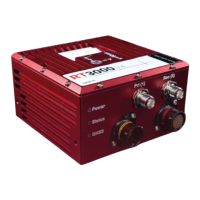Oxford Technical Solutions Ltd Page 35 of 110
being generated. The trigger inputs have a pull-up resistor so they can be used with a switch or as a CMOS
input.
Input signal characteristics:
0 V and 5 V input
low < 0.6 V
high > 2.6 V
In output mode, the trigger generates pulses based on distance or in synchronisation with the IMU clock rate.
The pulse width of the distance-based signal is 1 ms, whereas the IMU sync signal has a duty cycle of
approximately 50%.
Output signal characteristics:
0 V and 5 V output
low <= 0.8 V
high >= 2.4 V
Camera mode is a software condition that is automatically entered when the PPM distance output is configured
as less than 1 PPM. It exists in order to generate time-stamped INS measurements synchronised with
distance-based output triggers. The output is called camera mode as it’s often used to trigger image recording
equipment, which can then be matched to the position measurements at the precise moment of the trigger.
Camera mode provides a method of achieving this.
To enter camera mode, configure a trigger as an output, and set the distance to less than one pulse per metre.
A signal will be generated according to the specifications above at the distance interval defined by the PPM
settings. At the same moment the trigger signal is output, a position measurement will be internally generated
and logged alongside the regular measurement data. To generate a real-time message in relation to the
camera trigger, it is necessary to select the ‘Output on camera trigger option’ on the Ethernet configuration
window.
Wheel speed input
The wheel speed 1A input accepts TTL pulses from an encoder on a single wheel. An encoder from a gearbox
should not be used, and simulated TTL pulses (e.g. converted from the CAN bus) should not be used either. The
timing of the wheel speed input pulses is critical and nothing should cause any delay to them.
The RT also accepts signals from quadrature wheel speed sensors. When using quadrature sensors, connect
one channel from the quadrature sensor to wheel speed 1A, and the other to wheel speed 1B input. The
odometer input should be configured as per a normal wheel speed sensor – the RT will automatically detect
the use of the quadrature sensor.
The wheel speed input requires less than 0.8 V for a low pulse and more than 2.4 V for a high pulse. Limited
protection is provided on this port, however the input voltage should not exceed 12 V.

